NFPA’s annual visual inspection of commercial fire sprinkler pipe and fittings
In the first installment of QRFS’ series on the inspection of commercial fire sprinklers, we detailed the National Fire Protection Association (NFPA) requirements for the annual visual inspection of sprinkler heads. NFPA 25: Standard for the Inspection, Testing, and Maintenance of Water-Based Fire Protection Systems also outlines an annual visual inspection of commercial fire sprinkler pipe and fittings:
From the 2017 Edition of NFPA 25
5.2.2* Pipe and Fittings. Sprinkler pipe and fittings shall be inspected annually from the floor level.
Since these eyeball inspections of both sprinkler heads and pipe and fittings are at the same interval and involve integrated components, personnel can view them in one shot. NFPA stipulates that the checkup is done from the floor level “because it is usually impractical to get closer to the piping for a more detailed inspection. The use of ladders or lifts is of limited benefit when compared to the cost. As noted with the inspection of sprinklers, a flashlight or binoculars can assist in the inspection of piping in buildings with high ceilings.”
Are you just looking for replacement parts for your commercial fire sprinkler system? If so, jump directly to our selection of commercial fire sprinkler heads, cover plates, escutcheons, and other components and tools, or just use the search bar to find what you’re looking for.
First, understand your local deficiency/impairment classification program
The basic language in NFPA code sets a pretty broad and strict mandate for identifying and addressing issues; one that implies that any problem must be fixed immediately or the system will not function. Of course, this is not always the case – and NFPA and numerous authorities having jurisdiction (AHJ) have accounted for this variation. Most state, local, and private jurisdictions have a tagging system to indicate an inspection was conducted as well as its findings. “These tagging programs use anywhere from two to five tags, with varying color schemes.”
For example, the City of Mesquite follows Texas law (section 34.720 of the Texas Administrative Code), which stipulates that a blue Inspection, Test and Maintenance Service (ITM) Tag must be filled out after “a new installation or a scheduled inspection, testing and maintenance (ITM) service.” This ITM contains various pieces of information, including the inspector’s name, license number, system status, etc. Mesquite, Texas tags are as follows:
- Again, a blue tag indicates the inspection was done.
- An additional green tag means the system is believed to be in compliance after an inspection.
- In contrast, a yellow tag signifies that the system is “noncompliant with applicable NFPA standards, is not being tested or maintained according to adopted standards, or found to contain equipment that has been recalled by the manufacturer, but the noncompliance or recalled equipment does not constitute an emergency impairment.”
- And a red tag means “a fire protection sprinkler system has an impairment which constitutes an emergency impairment.”
Tagging and the classification of impairments can vary by individual jurisdiction, so make sure to look up your locally-applicable code.
Tags are not the end-all-be-all of system evaluation. A green tag, for example, could be placed inappropriately due to a faulty inspection or the system could be deemed compliant to the best of the inspector’s ability but still have issues. This is one of the reasons NFPA outlines testing and maintenance requirements in addition to inspection. For example, an annual visual inspection won’t spot corrosion on the inside of a pipe that could cause leaks or loss of pressure, but a hydrostatic test of the system will. In the end, it’s important to comply with all aspects of NFPA 25 to the best of your ability to ensure that a system functions properly.
In 2011, NFPA made changes to NFPA 25 that allow inspectors to classify issues in a three-level spectrum:
- Non-critical deficiency (yellow): NFPA defines this as a “deficiency that does not have a material effect on the ability of the fire protection system or unit to function in a fire event, but correction is needed to meet the requirements of this standard or for the proper inspection, testing, and maintenance of the system or unit.”Examples include “missing signs, a broken handle on an inspector’s test valve, or an inadequate number of spare sprinklers.” (NFPA 25: 3.3.7.2)
- Critical deficiency (orange): NFPA defines this as a “deficiency that, if not corrected, can have a material effect on the ability of the fire protection system or unit to function as intended in a fire event.”Examples include “a painted or damaged sprinkler, a faulty pressure-reducing hose valve, or an inaccessible fire hydrant.” (3.3.7.1)
- Impairment (red): “A condition where a fire protection system or unit or portion thereof is out of order, and the condition can result in the fire protection system or unit not functioning in a fire event.” (3.3.21) There are two types of impairments:Emergency Impairment: “A condition where a water-based fire protection system or portion thereof is out of order due to an unplanned occurrence, or the impairment is found while performing inspection, testing or maintenance activities.” (3.3.21.1)Preplanned Impairment: “A condition where a water-based fire protection system or a portion thereof is out of service due to work planned in advance, such as revisions to the water supply or sprinkler system piping.” (3.3.21.2)
These different levels of deficiency or impairment were designed to allow “a municipality to choose its own timeline and level of involvement in corrective measures.” Thus, an inspector should use this framework to evaluate each potential issue that’s spotted. Is it a non-critical deficiency, a critical deficiency, or a genuine impairment to the function of the system?
Issues to look for in pipe
The annual visual inspection of the pipe is looking for any damage, leakage, or corrosion. You must also make sure that nothing is leaning or hanging from the pipe and putting stress on it.
From the 2017 Edition of NFPA 25
5.2.2.1* Pipe and fittings shall be free of mechanical damage, leakage, and corrosion.
5.2.2.2 Sprinkler piping shall not be subjected to external loads by materials either resting on the pipe or hung from the pipe.
Mechanical damage “is the loss of material due to a mechanical action.” Basically, this is anything that has struck, cut, bent, scratched, abraded, or otherwise put pressure on a pipe to change its shape, alignment, or any other physical characteristic that could impact its performance.
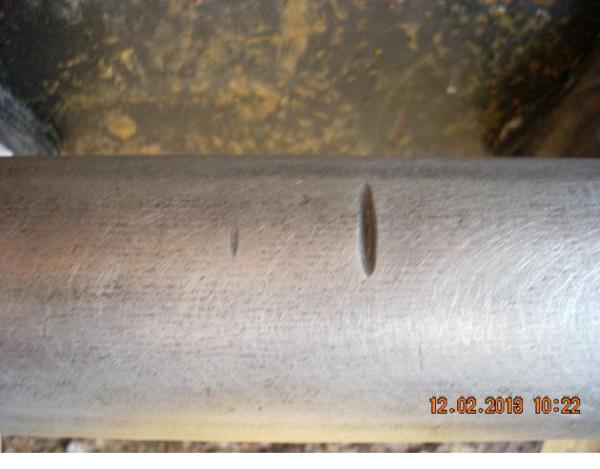
Leakage
Leaks can be caused by corrosion, improper fittings, mechanical damage, pipes that expand after freezing, and other factors. They should be fairly easy to spot in a wet sprinkler system. Even subtle leaks should leave signs of a wet spot on a floor or wall. Localized corrosion without a wet spot could be a sign of a slow leak. And if water is streaming from the pipe, you’ll obviously know it.
NFPA makes a distinction between “spraying or running water” and “slowly dripping water.” The former is a legitimate impairment – the loss of pressure will compromise the operation of the system – whereas milder but active leaks are a critical deficiency.
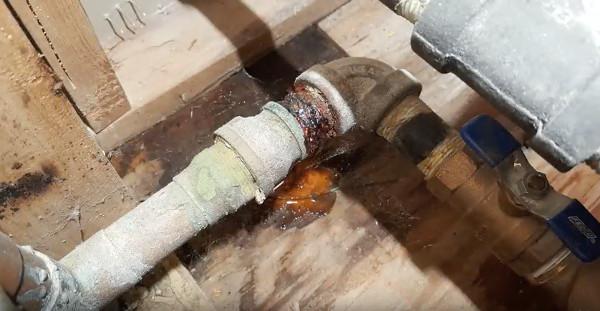
Leaks in the pipe of dry or preaction systems are harder to identify since the pipe is filled with pressurized gas. A leak would be indicated by an air or hydrostatic test, or a loss in pressure that causes a system’s air compressor to cycle more often. A leak that is significant enough to cause pressure loss equivalent to a sprinkler activation could even deploy the system.
Some manufacturers have created leak detectors that detect the ultrasonic noise created by a dry system leak. That said, obvious pinhole leaks caused by corrosion may be spotted in dry pipe.
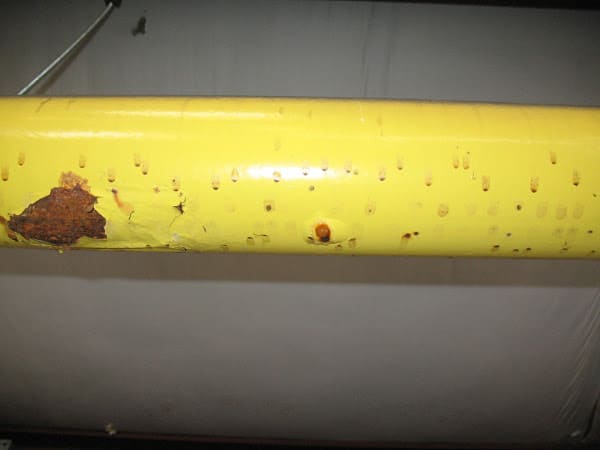
Corrosion
Most commercial systems use metallic pipe, and there are numerous corrosion threats to metal. Safety testing organization FM Global regards corrosion as “one of the major issues for maintenance and operation of Fire Protection Systems” and notes that the “repair cost of corrosion damage due to mechanical failure or water damage adds significantly to the lifecycle cost.”
There are nine types of corrosion, ranging from uniform corrosion or localized pitting corrosion to environmentally-induced cracking and microbiologically-influenced corrosion (MIC). Regardless of the specific variety, there are two main threats to pipe caused by corrosion:
- Pitting or other damage that compromises the integrity of the pipe, causing leaks.
- The build-up of corrosion sediment within the pipe can block water flow.
Dry pipe is more subject to corrosion because of the periodic introduction of water during testing and the constant presence of oxygen at other times. Strategies to mitigate corrosion include avoiding contamination during installation, getting rid of trapped air in wet sprinkler pipe (the oxygen is fuel for corrosion) through a relief valve, minimizing any draining and refilling of the system (which introduces more oxygen), using galvanized pipe and pressurized nitrogen instead of air in preaction systems, and several other measures.
Regardless, some corrosion of metallic pipe is inevitable. Corrosion can also occur in the CPVC pipe used in lighter hazard commercial settings, typically due to its exposure to substances that have a chemical reaction with the thermoplastic. Whatever the cause or exact material, inspectors must look for and classify corrosion.
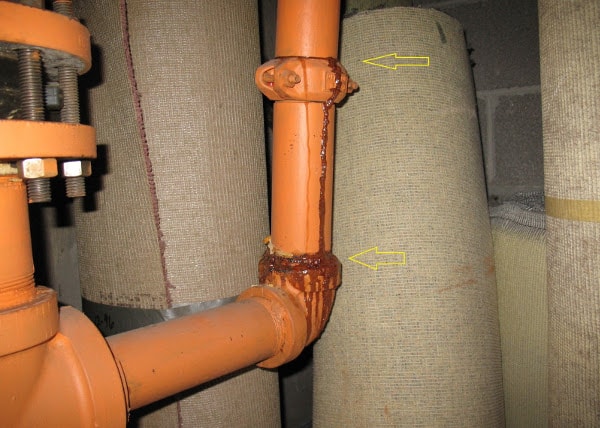
External loads
This requirement is pretty simple. Nothing except a system component should be hanging, leaning, or otherwise putting weight on a pipe. This is a zero-tolerance policy because “the additional weight from other loads is not considered in the design of the system.” And zero-tolerance means zero-tolerance. NFPA even specifies that signs, decorations, and coaxial cables of “negligible” weight must not be touching the pipe unless something is specifically listed for use and designed to be there.
Issues to look for in hangers, braces, and supports
In addition to looking at the pipe, inspectors must examine the equipment that supports it. Improper or failed hangers, braces, and supports could cause a sprinkler to become blocked or disorientated from the intended coverage area, or put pressure on pipe that causes it to fail.
From the 2017 Edition of NFPA 25
5.2.3* Hangers, Braces, and Supports. Sprinkler pipe hangers, braces, and supports shall be inspected annually from the floor level.
5.2.3.1 Hangers, braces, and supports shall not be damaged, loose, or unattached.
5.2.3.2 Hangers, braces, and supports that are damaged, loose, or unattached shall be replaced or refastened.
Hangers, as the name implies, are extensions that a pipe hangs from, and they are usually bolted into a ceiling. Braces clamp pipe against something to support it; for example, NFPA requires that a sprig (any section of pipe that rises vertically and supplies a single sprinkler) which is more than 4 feet long must “be restrained against lateral movement.” A brace might do the job. Finally, supports are anything that supports the pipe from below. An inspection should check if any of these structures are damaged, loose, or unattached, as well as if someone incorrectly installed them or used unacceptable materials in the first place. Just as you must make sure a pipe is not subject to external loads, the supports have to ensure that the load of the pipe is supported properly.
It’s important to understand the concepts of loading and axial loading, in particular. An axial load is a force that acts parallel to the axis of rotation of an object. For example, a hanger that hangs straight down from the ceiling would have an axial load (force) that acts up and down along its height. If a hanger (or a support) becomes bent at an angle, it is under non-axial load, which can cause it to fail.
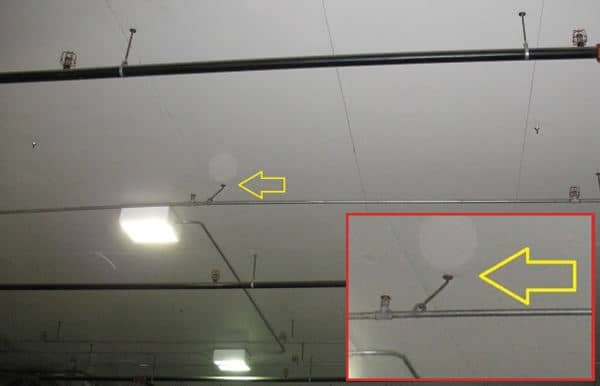
In addition, a structural engineer ideally calculates the load that sprinkler pipe imposes on the portion of the building it’s attached to during installation, ensuring that it adheres to a “maximum load.” For example, NFPA 13 outlines this basic specification for hangers:
From the 2016 Edition of NFPA 13
9.2.1.3.1 Sprinkler piping shall be substantially supported from the building structure, which must support the added load of the water-filled pipe plus a minimum of 250 lb (115 kg) applied at the point of hanging, except where permitted by 9.2.1.1.2, 9.2.1.3.3, and 9.2.1.4.1.
A hanger connected to the ceiling with a drywall screw is not going to meet this standard.
And while the section of the building must support the pipe weight plus 250 lbs., the hanger itself “must be designed to support five times the weight of the water filled pipe plus 250 pounds.” Obviously, sprinkler pipe suspended by a coat hanger would not meet this qualification, nor does a legitimate hanger that’s come loose from the ceiling or become severely bent.
Engineers calculate acceptable loads according to pipe size, weight, and length, and a variety of manufacturers provide supporting accessories to meet various requirements. Some issues may require a trained professional to spot, but some strangely inadequate installs have somehow been approved during acceptance inspection. Both these examples and defects that have happened over time may be pretty obvious.
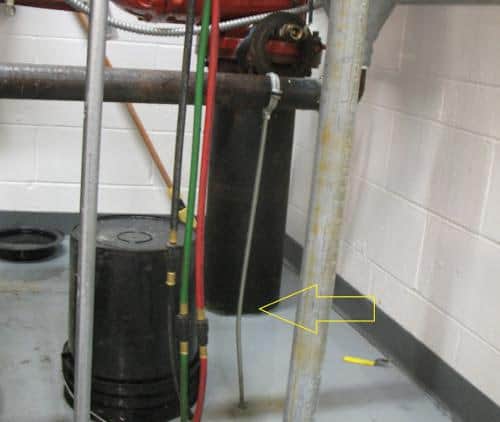
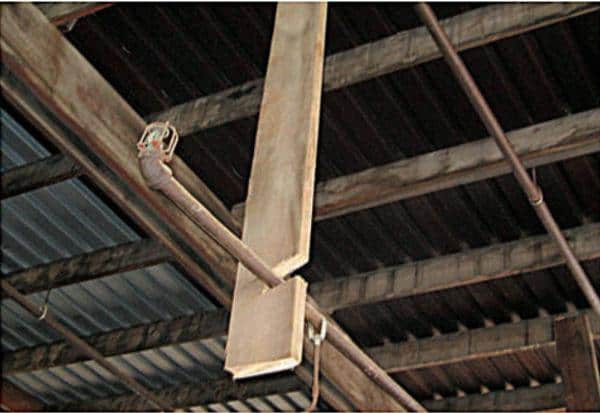
Exceptions to annual visual inspection of fire sprinkler pipe and fittings
NFPA outlines rigorous inspection requirements for commercial fire sprinklers, but it has made practical accommodations:
From the 2017 Edition of NFPA 25
5.2.2.3* Pipe and fittings installed in concealed spaces such as above suspended ceilings shall not require inspection.
5.2.2.4 Pipe and fittings installed in areas that are inaccessible for safety considerations due to process operations shall be inspected during each scheduled shutdown.
5.2.3.3* Hangers, braces, and supports installed in concealed spaces such as above suspended ceilings shall not require inspection.
5.2.3.4 Hangers, braces, and supports installed in areas that are inaccessible for safety considerations due to process operations shall be inspected during each scheduled shutdown.
NFPA’s rationale for the exceptions are two-fold: “It is costly and impractical to inspect [piping, hangers, and braces] in these spaces” and the “inaccessibility of such [piping, hangers, and braces] means [they are] less likely to be damaged or otherwise affected than [these elements] in an open space.”
To be continued: What Facility Managers Need to Inspect on a Fire Sprinkler System
This concludes part two of our review of inspection requirements for commercial fire sprinklers. In the next installment of this series, we cover the inspection of fire pumps, waterflow alarms, and other components. If you need to buy parts for your commercial fire sprinkler system, check out QRFS’ selection of commercial fire sprinkler heads, cover plates, escutcheons, and other components and tools, or just use the search bar at the top of the page to find what you’re looking for.
If you have any questions about commercial fire sprinklers or need help finding a part, give us a call at 888.361.6662, comment below, or fill out our contact form and we’d be happy help.


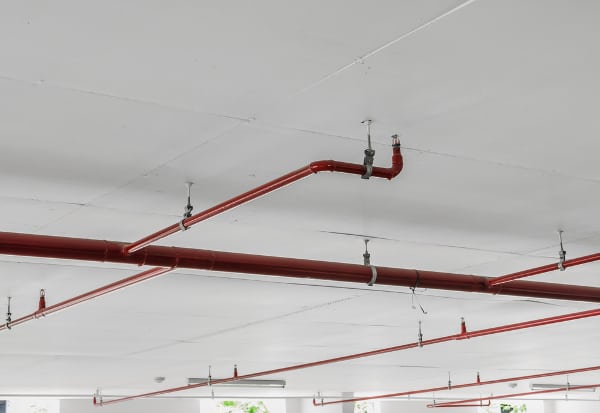
We are an industrial facility. Our specification on the fire sprinkler lines are threaded connections for pipe size of 2 and half inch and smaller. Can we use grooved connection for the pipe size of 2 inch and smaller ?
Comparing threaded connection and grooved connection, what are the concerns on their maintenance and the cost ?
Can we use the grooved connection for the fire sprinkler itself ?
Your advices will be much appreciated.
Rui
Rui, thanks for commenting! When considering what grooved connections are best for your fire sprinkler system, you should work with a licensed sprinkler designer and/or contract to ensure the proper set up. When comparing different types of sprinkler connections, we recommend MeyerFire’s Methods of Connecting Fire Sprinkler Pipe article.
admirable info about fire protection buildings
It’s good to know that blue means the inspection was done properly. My brother is trying to get a new landscape around his building. He wants to make sure it looks great for customers.
Brendan — Blue for a completed inspection and green for a compliant system are the colors used by Mesquite, TX, and other jurisdictions, but the colors may vary in your area. Also, note that these tags specifically govern fire protection systems. Thanks for reading!
In the code/standard it refers to as nothing load barring can be held up or against a sprinkler system, what about wires touching the system?
Paul — The relevant NFPA 25 section in the piece we believe you are referring to (5.2.2.2) says “subjected to external loads,” which is any load and has a somewhat different (more stringent) implication than “load-bearing” (e.g., a structural element designed to support something heavy). In addition, NFPA 13 (2022) addresses the specific situation (wire) here:
Wires in a preaction system or something like heat tape in a wet system are part of the system and excepted from the prohibition. But non-system components are barred; as the standard further explains:
The section also shows an image of electrical conduit draped over a sprinkler pipe as a visual example.
Thus, if the pipe is supporting the wire, it is a problem, according to NFPA 13. There may also be other issues depending on the pipe material; CPVC, for example, has strict rules about what substances can touch the pipe to avoid chemical incompatibilities that can lead to stress fractures, etc.
You can contact an appropriate authority having jurisdiction or fire protection ITM pro to assess the situation.
Thanks for reading!
Can anyone tell me in laymen’s terms what is the NFPA or OSHA code for using inspections tags and where to find if required?
Mike — Unfortunately, where NFPA and the jurisdictions that enforce it are concerned, there is no one-size-fits-all set of tagging rules. Individual jurisdictions (local or state rules) have their own schemes, though many are identical or similar and involve using various color-coded tags (red, green, and sometimes other colors). Even insurance companies may require unique tagging systems.
NFPA tagging requirements are minimal and found in the standard that’s relevant to the system type. NFPA 25 covers water-based systems and includes this requirement for impairments (though many tagging systems also tag less-serious “deficiencies”):
That said, NFPA 25 also offers an entire Annex G that details a suggested “Color-Coded Tagging Program.” Nevertheless, the bottom line is that you should figure out what jurisiction applies to a system and see how the local authorities tag systems.
This QRFS blog has more about NFPA’s suggested tagging program as well as deficiencies vs. impairments. Hope that helps and thanks for reading!